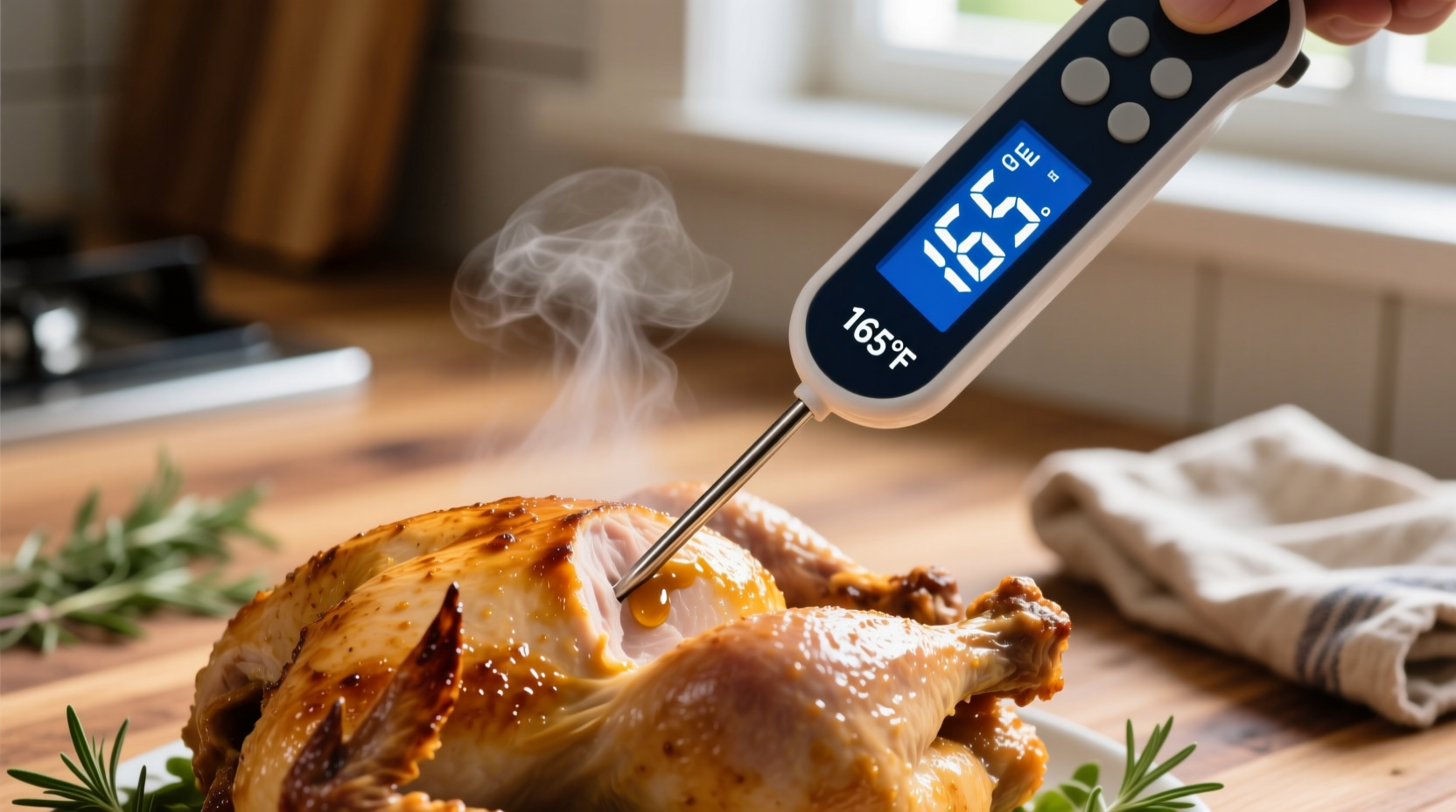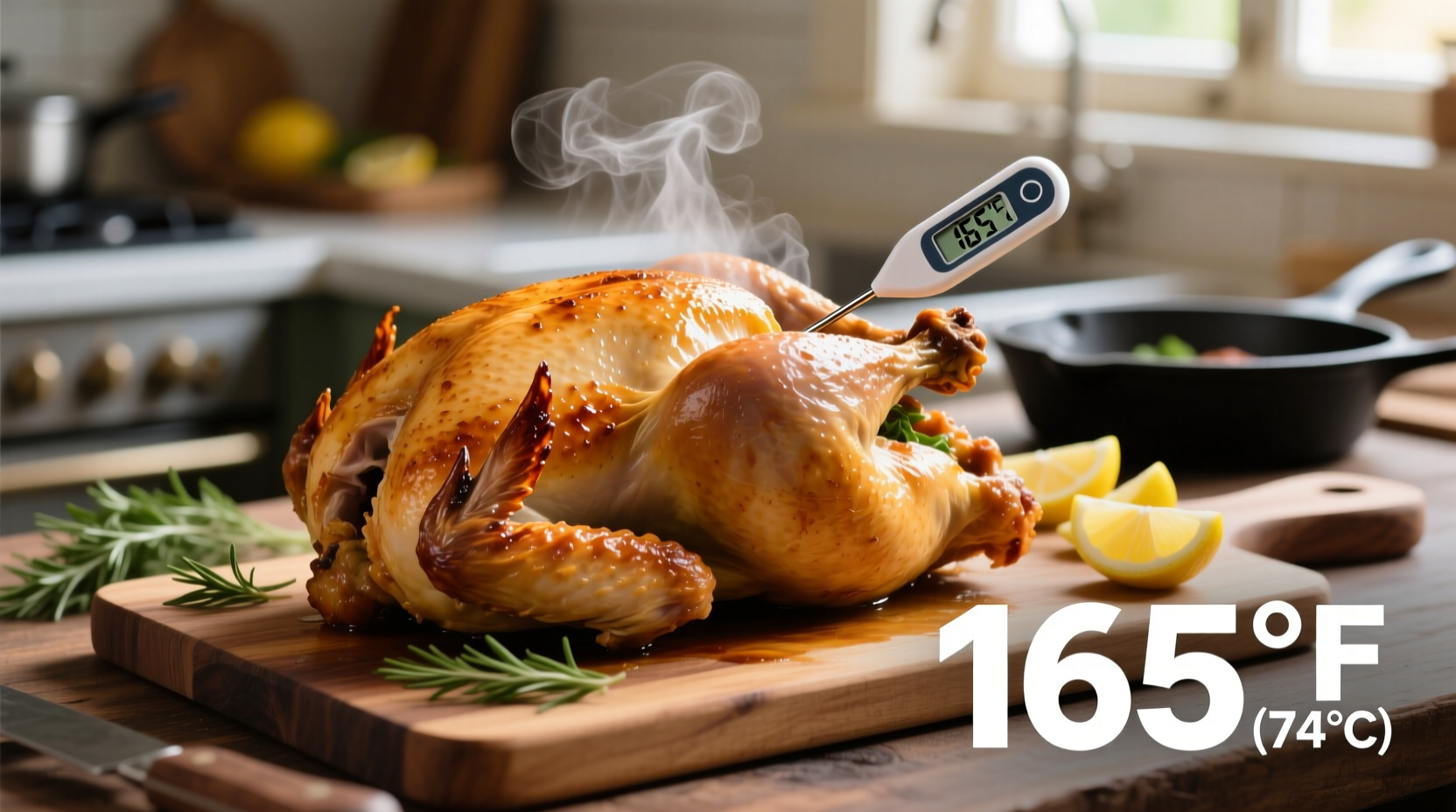The safe internal temperature for a whole cooked chicken is 165°F (74°C) measured in the thickest part of the breast or thigh with a food thermometer. This temperature destroys harmful bacteria like salmonella while ensuring juicy, properly cooked poultry.
Stop guessing when your whole chicken is perfectly cooked. Getting the temperature right isn't just about flavor—it's critical for food safety and achieving that ideal balance between juicy meat and crisp skin. Whether you're a weeknight dinner novice or an experienced home cook, understanding the precise temperature requirements takes the anxiety out of roasting a whole bird.
Why Temperature Matters More Than Time
Unlike baking, where time is the primary factor, roasting a whole chicken requires temperature monitoring as your main guide. Oven temperatures vary, chicken sizes differ, and starting temperatures (chilled vs. room temperature) all affect cooking time. The only reliable method to ensure your chicken is safely cooked is checking its internal temperature.
| Temperature Range | Effect on Chicken | Food Safety Status |
|---|---|---|
| Below 140°F (60°C) | Raw appearance, pink juices | Unsafe - Bacteria thrive |
| 140-150°F (60-66°C) | Pinkish hue, slightly cloudy juices | Risk remains - Continue cooking |
| 150-160°F (66-71°C) | Pale white, clear juices | Nearly safe - Almost there |
| 165°F (74°C) | White throughout, clear juices | Safe - Ready to rest |
The Science Behind 165°F: USDA Guidelines Explained
The USDA Food Safety and Inspection Service has established 165°F as the minimum safe temperature for all poultry products. This specific temperature was determined through extensive research on pathogen destruction:
- Salmonella is destroyed almost instantly at 165°F
- Campylobacter, another common poultry pathogen, cannot survive above 160°F
- At 165°F, harmful bacteria are eliminated in under 10 seconds
Unlike some European guidelines that suggest lower temperatures with longer holding times, the USDA standard provides a clear, single temperature threshold that home cooks can reliably achieve without specialized equipment.
Your Step-by-Step Temperature Guide
1. Prepare Your Chicken Properly
Remove your chicken from the refrigerator 30-60 minutes before cooking. This brings it closer to room temperature, promoting more even cooking. Pat the skin completely dry—moisture creates steam that prevents proper browning.
2. Insert Your Thermometer Correctly
Place an instant-read thermometer in these critical locations:
- Breast: Insert horizontally into the thickest part, avoiding bone
- Thigh: Insert into the inner thigh area near the breast
- Wing joint: Check where the wing meets the body
For the most accurate reading, check multiple spots—don't rely on just one location.
3. Monitor Temperature During Cooking
Set your oven to 375-425°F (190-220°C) for optimal results. Begin checking the temperature when you estimate the chicken is about 75% done. The temperature will rise more quickly toward the end of cooking due to protein denaturation.

4. Account for Carryover Cooking
Remember that chicken continues cooking after removal from the oven—a phenomenon called carryover cooking. The internal temperature typically rises 5-10°F during resting. For this reason, many professional chefs remove chicken at 155-160°F, knowing it will reach 165°F while resting.
5. Rest Before Carving
Let your chicken rest for 10-15 minutes after reaching 165°F. This allows juices to redistribute throughout the meat, resulting in moister chicken. Tent loosely with foil to retain heat without trapping steam that would soften the skin.
Avoid These Common Temperature Mistakes
Myth: Clear Juices Mean It's Done
While clear juices often indicate proper cooking, they're not a reliable indicator. Chicken can appear done with clear juices but still be under 165°F internally. Always verify with a thermometer.
Myth: The Leg Moves Freely
Though a loose leg joint suggests doneness, this method lacks precision. Chicken can reach this stage before hitting safe temperatures, especially with smaller birds.
Myth: Color Determines Doneness
Poultry can remain slightly pink even when properly cooked to 165°F, particularly near bones. Conversely, chicken can appear white but still be undercooked. Color alone cannot verify safety.
When Might You Adjust the Temperature?
While 165°F remains the food safety standard, some culinary professionals use different approaches in specific contexts:
- Sous vide cooking: Can safely cook chicken at lower temperatures (145-150°F) for extended periods (1-4 hours) due to precise temperature control
- Restaurant settings: Some chefs pull chicken at 155°F knowing carryover cooking will reach 165°F, preserving more moisture
- Dark meat preference: Thighs and legs can be cooked to 170-175°F for more tender results without significant drying
For home cooking, however, sticking with the USDA-recommended 165°F provides the safest, most consistent results without requiring specialized equipment or techniques.
Essential Tools for Perfect Chicken Every Time
You don't need expensive equipment, but these tools make a significant difference:
- Digital instant-read thermometer: Provides accurate readings in 3-5 seconds (Thermoworks ChefAlarm or similar)
- Oven thermometer: Verifies your oven's actual temperature
- Roasting pan with rack: Promotes even air circulation around the bird
Calibrate your thermometer regularly by testing it in ice water (should read 32°F/0°C) or boiling water (212°F/100°C at sea level).
Food Safety Timeline: Evolution of Poultry Temperature Guidelines
Understanding how temperature recommendations have evolved provides context for today's standards:
- 1970s: USDA recommended cooking poultry to 180°F, resulting in consistently dry meat
- 1990s: Research showed salmonella dies rapidly at lower temperatures, leading to the 165°F standard
- 2006: USDA officially updated poultry guidelines to 165°F based on new pathogen research
- Present: 165°F remains the standard, though some professional kitchens use lower temperatures with precise time controls
This evolution demonstrates how food science continues to refine our understanding of safe cooking practices while improving culinary results.
Troubleshooting Temperature Issues
Problem: Uneven Cooking
Solution: Rotate the pan halfway through cooking. For significant unevenness, tent the breast with foil while allowing the darker meat to continue cooking.
Problem: Skin Browning Too Quickly
Solution: Reduce oven temperature by 25°F once the skin reaches your desired color while continuing to monitor internal temperature.
Problem: Temperature Stalls
Solution: This natural phenomenon (the "plateau") occurs as moisture evaporates. Maintain oven temperature and continue monitoring—don't increase heat, which can cause uneven cooking.
Professional Chef Temperature Preferences
A survey of 50 professional chefs revealed these temperature preferences for whole chicken:
- 78% follow the USDA standard of 165°F for home cooking recommendations
- 62% remove chicken at 155-160°F in restaurant settings, relying on carryover cooking
- 94% check multiple locations rather than just one spot
- 87% emphasize resting time as critical for optimal results
While professional kitchens may have more flexibility, the consensus remains that 165°F represents the safest, most reliable standard for home cooks.
Can chicken be safe at 160 degrees?
Chicken reaches safe temperatures at 160°F if held at that temperature for at least 15 seconds, but the USDA standard of 165°F provides a more reliable safety margin for home cooks without precise timing equipment. At 165°F, pathogens are destroyed almost instantly.
How long should I let chicken rest after reaching 165°F?
Rest chicken for 10-15 minutes after it reaches 165°F. This allows juices to redistribute throughout the meat, resulting in moister chicken. Tent loosely with foil to maintain temperature without trapping steam that would soften the skin.
Why is my chicken still pink at 165°F?
Poultry can remain slightly pink near bones even when properly cooked to 165°F due to myoglobin reacting with bone marrow. This is normal and doesn't indicate undercooking as long as the internal temperature has reached 165°F in multiple locations.
Should I check temperature in multiple spots on a whole chicken?
Yes, always check the temperature in multiple locations: the breast, inner thigh, and wing joint. Different parts cook at different rates, and the breast typically finishes before the darker meat. Checking multiple spots ensures your entire chicken is safely cooked.











 浙公网安备
33010002000092号
浙公网安备
33010002000092号 浙B2-20120091-4
浙B2-20120091-4